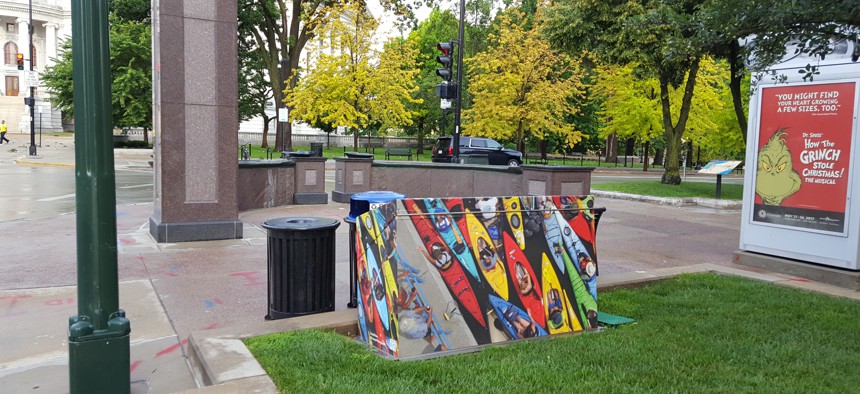Bringing Art to Public Utility Boxes

Past designs include abstract patterns and photographs. city of Madison
The city of Madison, Wisconsin is expanding a program that decorates utility boxes with designs by local artists.
The city of Madison, Wisconsin is expanding a public art project that places local artists’ designs on utility boxes throughout the downtown area.
The utility box art program, a collaboration between the city’s art commission and its downtown coordinating committee, began in 2016 as a pilot project with an initial batch of four decorated boxes. More than 20 additional boxes were decorated for the 2017-2018 season, with 14 to go. The city hopes to add another five or six for the 2018-2019 term, said Karin Wolf, program administrator for Madison Arts.
“It has been a big hit in the community and we have decided to continue it and have another round of boxes next summer,” Wolf told Route Fifty.
To be considered, images must not contain legible logos, letters or numbers that could be mistaken for a sign in a right-of-way. Designs can’t promote or advertise organizations or businesses, and must have the ability to be enlarged to more than 4 feet by 6 feet in size.

Artists must reside in Madison and can have a maximum of four boxes apiece. Any submitted art must “be able to translate well to a utility box wrap, such that parts of the image may be repeated, doubled, flipped or even removed,” according to the submission guidelines. Existing designs include overhead photographs of a bike race and several colorful, abstract patterns.
Winning designs are printed on vinyl wraps—similar to what you’d find on a car decked out in advertisements or graphics—and applied to the utility boxes one at a time. The vinyl is guaranteed for seven years, and should hold up during both Wisconsin’s fierce winters and its occasionally scorching summers. Each box takes about 45 minutes to complete and is done a side at a time, according to Adam Hegge, owner of Madison Graphics Co., the city’s vendor for the latest round of decorations.
“I’ll bring two guys over and we’ll just start with the front and the back and then go to the sides,” Hegge said. “They’re all close to the same size. When you go around certain areas, you do have to apply heat and shrink the vinyl to fit.”
Utility box art projects are somewhat common across the U.S. as a way to both beautify city streetscapes and discourage graffiti. Most cities (among them Redwood City, California; San Luis Obispo, California and Sequim, Washington) opt to have artists paint the boxes directly rather than wrap them in vinyl.
Madison’s project aims to inject art onto a normally drab part of the public realm while also giving artists public exposure in their home city, according to the Madison Arts Commission. It’s received positive feedback from residents on social media and via email, including one woman who wrote to the city to request a map of the wrapped boxes for a walking tour.
“Of course it's always neat to enjoy them by happenstance. But I can't help but wonder what I am missing!” she wrote. “Public art rocks! … Thank you so much for bringing art to unexpected places.”

Hegge gets similar feedback from people passing by while crews are wrapping boxes, he said.
“Every single time we’re putting one on we get at least four or five comments,” he said. “People are like, ‘Wow, that’s awesome,’ or, ‘Thanks for doing that.’ People are open to the idea and they like the fact that we’re spreading this art throughout the city.”
Kate Elizabeth Queram is a Staff Correspondent for Government Executive’s Route Fifty and is based in Washington, D.C.
NEXT STORY: Michigan Daycare Center Reports High PFAS in Its Water






